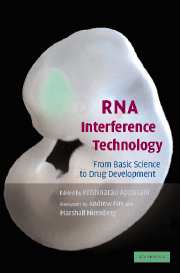Book contents
- Frontmatter
- Contents
- Foreword by Andrew Fire
- Foreword by Marshall Nirenberg
- List of Contributors
- Introduction
- Section one Basic RNAi, siRNA, microRNAs and gene-silencing mechanisms
- Section two Design, synthesis of siRNAs
- Section three Vector development and in vivo, in vitro and in ovo delivery methods
- 10 Six methods of inducing RNAi in mammalian cells
- 11 Viral delivery of shRNA
- 12 siRNA delivery by lentiviral vectors: Design and applications
- 13 Liposomal delivery of siRNAs in mice
- 14 Chemical modifications to achieve increased stability and sensitive detection of siRNA
- 15 RNA interference in postimplantation mouse embryos
- 16 In ovo RNAi opens new possibilities for functional genomics in vertebrates
- Section four Gene silencing in model organisms
- Section five Drug target validation
- Section six Therapeutic and drug development
- Section seven High-throughput genome-wide RNAi analysis
- Index
- Plate section
- References
15 - RNA interference in postimplantation mouse embryos
Published online by Cambridge University Press: 31 July 2009
- Frontmatter
- Contents
- Foreword by Andrew Fire
- Foreword by Marshall Nirenberg
- List of Contributors
- Introduction
- Section one Basic RNAi, siRNA, microRNAs and gene-silencing mechanisms
- Section two Design, synthesis of siRNAs
- Section three Vector development and in vivo, in vitro and in ovo delivery methods
- 10 Six methods of inducing RNAi in mammalian cells
- 11 Viral delivery of shRNA
- 12 siRNA delivery by lentiviral vectors: Design and applications
- 13 Liposomal delivery of siRNAs in mice
- 14 Chemical modifications to achieve increased stability and sensitive detection of siRNA
- 15 RNA interference in postimplantation mouse embryos
- 16 In ovo RNAi opens new possibilities for functional genomics in vertebrates
- Section four Gene silencing in model organisms
- Section five Drug target validation
- Section six Therapeutic and drug development
- Section seven High-throughput genome-wide RNAi analysis
- Index
- Plate section
- References
Summary
Introduction
Sequencing of whole genomes has provided new perspectives into the blueprints of diverse organisms, including the genome of the mouse (Waterston et al., 2002). Although the complete sequence is now available, the estimation of total gene number encoded by the mouse genome is ranging approximately from 25,000 to 50,000 (Okazaki et al., 2002). This uncertainty about the functional units within the genome highlights the importance of a detailed analysis of the encoded genes.
A significant step toward a better understanding of the genome has been the development of large-scale gene expression analysis tools utilizing DNA microarrays (Bono et al., 2003). This technology allows the generation of gene expression profiles that can give important clues for the interpretation of biological processes. However, the obtained data do not directly address the function of individual genes. Rather, they present a snapshot of global gene expression changes. While this is a very useful parameter for understanding the genome, it is not very useful for studying detailed phenotypic changes after gene ablation.
About 15 years ago gene function analysis became available in the mouse through the development of gene knock-out technology (Capecchi, 1989). In this approach genes are targeted in embryonic stem (ES) cells through homologous recombination. The manipulated ES cells are subsequently injected into blastocysts, and chimeric offspring are checked for germline transmission. Successful germline transmission allows the production of animals deficient in the gene of interest. Careful phenotypic analyses of these animals can then disclose the function(s) of the knocked-out gene.
- Type
- Chapter
- Information
- RNA Interference TechnologyFrom Basic Science to Drug Development, pp. 207 - 219Publisher: Cambridge University PressPrint publication year: 2005



